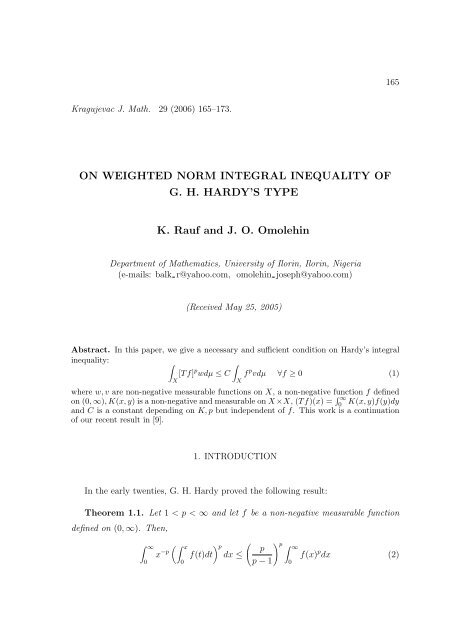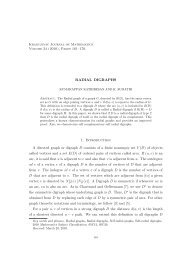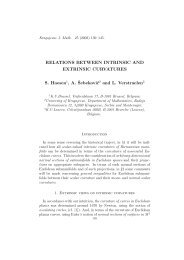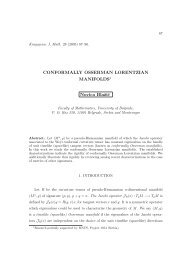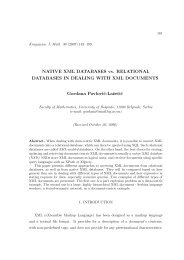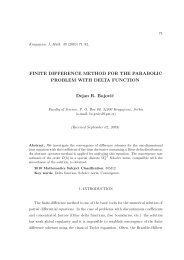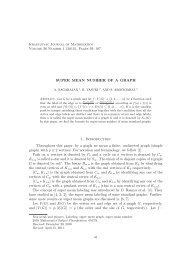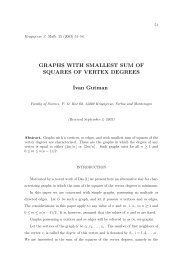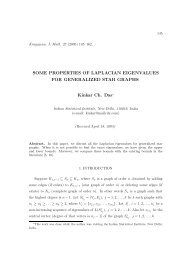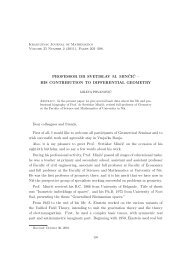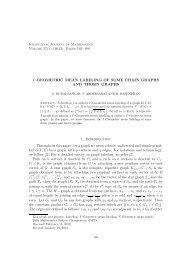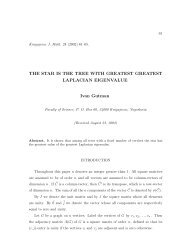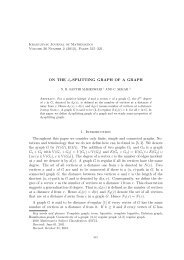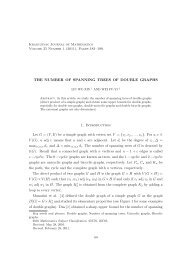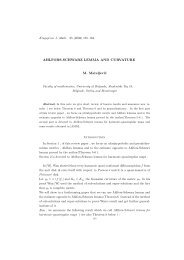ON WEIGHTED NORM INTEGRAL INEQUALITY ... - Kjm.pmf.kg.ac.rs
ON WEIGHTED NORM INTEGRAL INEQUALITY ... - Kjm.pmf.kg.ac.rs
ON WEIGHTED NORM INTEGRAL INEQUALITY ... - Kjm.pmf.kg.ac.rs
Create successful ePaper yourself
Turn your PDF publications into a flip-book with our unique Google optimized e-Paper software.
165<br />
Kragujev<strong>ac</strong> J. Math. 29 (2006) 165–173.<br />
<strong>ON</strong> <strong>WEIGHTED</strong> <strong>NORM</strong> <strong>INTEGRAL</strong> <strong>INEQUALITY</strong> OF<br />
G. H. HARDY’S TYPE<br />
K. Rauf and J. O. Omolehin<br />
Department of Mathematics, Unive<strong>rs</strong>ity of Ilorin, Ilorin, Nigeria<br />
(e-mails: balk r@yahoo.com, omolehin joseph@yahoo.com)<br />
(Received May 25, 2005)<br />
Abstr<strong>ac</strong>t. In this paper, we give a necessary and sufficient condition on Hardy’s integral<br />
inequality:<br />
∫<br />
∫<br />
[T f] p wdµ ≤ C f p vdµ ∀f ≥ 0 (1)<br />
X<br />
where w, v are non-negative measurable functions on X, a non-negative function f defined<br />
on (0, ∞), K(x, y) is a non-negative and measurable on X ×X, (T f)(x) = ∫ ∞<br />
0<br />
K(x, y)f(y)dy<br />
and C is a constant depending on K, p but independent of f. This work is a continuation<br />
of our recent result in [9].<br />
X<br />
1. INTRODUCTI<strong>ON</strong><br />
In the early twenties, G. H. Hardy proved the following result:<br />
Theorem 1.1. Let 1 < p < ∞ and let f be a non-negative measurable function<br />
defined on (0, ∞). Then,<br />
∫ ∞ (∫ x<br />
x −p<br />
0<br />
0<br />
) ( ) p p<br />
p<br />
∫ ∞<br />
f(t)dt dx ≤ f(x) p dx (2)<br />
p − 1 0
166<br />
holds.<br />
For a proof (see [3]).<br />
It has wide applications in differential and integral equations, Lapl<strong>ac</strong>e transforms<br />
and Fourier series (See [1, 2, 4, 5, 8, 10] and [11]) for related works. Recently, B.<br />
Mucheuhoupt [7] raised the question that given the weight w, under what condition<br />
will there exist a weight function v, finite µ−almost everywhere on X such that the<br />
inequality (1) holds. In their attempt to simplify this problem, R. Kerman and E.<br />
Sawyer [6] provided partial solution to his question and two new open problems were<br />
generated. In [9], the proof of the following theorem, among othe<strong>rs</strong>, on weighted norm<br />
inequalities for positive sublinear operator was established:<br />
Theorem 1.2. Let 1 < p < ∞ and suppose w is a weight on X. Define the<br />
sublinear operator T by T (f + g)(x) = ∫ X K(x, y)(f + g)(y)dµ(y) then, there exists a<br />
weight function v, finite µ−almost everywhere on X such that ∫ X [T (f + g)]p wdµ ≤<br />
C(K, p) ∫ X (f p + g p )vdµ holds, for all f, g > 0, if and only if there is a positive<br />
function Φ and θ on X with ∫ X (T Φ)p wdµ < ∞ and ∫ X (T θ)p wdµ < ∞ or equivalently<br />
Φ 1−p T ∗ ((T Φ) p−1 w) < ∞ and Φ 1−p T ∗ ((T θ) p−1 w) < ∞ respectively, C(K, p) =<br />
max [C 1 (K, p), C 2 (K, p)] is a constant independent of f and g.<br />
The proof is ex<strong>ac</strong>tly as in [9]. Thus, we omit it.<br />
This theorem is known to have provided partial solution to the open problem<br />
number one in [6]. The aim of the present paper is to extent our recent result in [9] to<br />
the case when T is a special integral operator and to consider the case of interchanging<br />
non-negative weight functions w for which there are non trivial v ’s. These provided<br />
partial solutions to the second open problem in [6].<br />
Throughout this work, we let (X, ζ, µ) be a σ−finite measure sp<strong>ac</strong>e, K(x, y) be a<br />
non-negative and measurable on X × X. Also, set (T f)(x) = ∫ ∞<br />
0 K(x, y)f(y)dy and<br />
(T ∗ f)(x) = ∫ ∞<br />
0 K(y, x)f(y)dy for non negative functions f.<br />
Furthermore, let p ′<br />
denotes the conjugate index of p, p ≠ 0 and is defined by<br />
1<br />
+ 1 = 1 with p p ′ p′ = ∞ if p = 1.
167<br />
2. STATEMENT OF RESULTS<br />
In this section, we state and prove our main results by induction and show that<br />
for all n ∈ ℵ, the nth partial sum of the left hand side of the inequality (3) is less<br />
than or equal to the nth partial sum of the right hand side.<br />
Theorem 2.1. Let 1 < p < ∞ and suppose v is a weight on X. Then there is a<br />
weight w, finite µ−almost everywhere on X, such that the weighted norm inequality:<br />
∑<br />
∫<br />
∫<br />
n∈ℵ<br />
[T f] p wdµ ≤ ∑ f p vdµ (3)<br />
X n n∈ℵ<br />
X n<br />
holds, for all f > 0, if and only if there is a positive function Φ on X with<br />
∫<br />
X<br />
[T ∗ Φ] p v 1−p′ dµ < ∞ (4)<br />
or equivalently,<br />
Φ 1−p T ∗ [ (T Φ) p−1 w ] < ∞ (5)<br />
µ−almost everywhere.<br />
in (5).<br />
We noted that the weighted norm inequality (3) holds with v equals to the weight<br />
Proof. Suppose that ∫ X [T ∗ Φ] p v 1−p′ dµ < ∞, where 1 p + 1 p ′<br />
= 1. Since X is a<br />
σ−finite measure sp<strong>ac</strong>e. X = ∪ ∞ n=1X n with X n ∩ X m = ∅, n ≠ m and µ(X n ) < ∞.<br />
We shall determine a necessary and sufficient condition on v such that the inequality<br />
(3) holds. But,<br />
and<br />
∫<br />
X<br />
Thus we need to show that<br />
∫<br />
[T f] p wdµ = f]<br />
∪ ∞ n=1 n[T p wdµ = ∑ ∫<br />
[T f] p wdµ<br />
X n∈ℵ<br />
X n<br />
∫<br />
∑<br />
∫<br />
n∈ℵ<br />
X<br />
f p vdµ = ∑ n∈ℵ<br />
∫<br />
X n<br />
[T f] p wdµ ≤ ∑ n∈ℵ<br />
X n<br />
f p vdµ<br />
∫<br />
X n<br />
f p vdµ
168<br />
Let n = 1, we have<br />
∫<br />
[T f] p wdµ =<br />
X 1<br />
=<br />
≤<br />
∫X 1<br />
[∫<br />
∫X 1<br />
[∫<br />
K(x, y)f(y)dµ(y)] p<br />
wdµ<br />
K(x, y) 1 −<br />
p f(y)Φ 1 p ′ K(x, y) 1 p ′ Φ 1 p<br />
p<br />
dµ(y)] ′ wdµ<br />
[ ∫<br />
∫<br />
]<br />
( K(x, y)f(y)<br />
∫X p Φ − p p ′ dµ(y)) 1 p ( K(x, y)Φdµ(y)) 1 p<br />
p ′ wdµ<br />
1<br />
By Holder’s inequality<br />
∫ [<br />
= (T f p Φ 1−p )(T Φ) p−1 w ] dµ<br />
X 1<br />
By a property of an inner product<br />
∫<br />
= f p vdµ<br />
X 1<br />
Hence, valid for n = 1.<br />
Next, assume n = k > 1, we have<br />
k∑<br />
∫<br />
[T f] p wdµ = [T f] p wdµ<br />
n=1<br />
∪<br />
∫<br />
k n=1 Xn ∫<br />
∫<br />
= [T f] p wdµ + [T f] p wdµ + . . . + [T f] p wdµ<br />
X 1 X 2 X<br />
∫<br />
∫<br />
∫<br />
k<br />
≤ f p vdµ + f p vdµ + . . . + f p vdµ<br />
X 1 X 2 X k<br />
By Holder’s inequality and using the above argument for n = 1<br />
∫<br />
= f p vdµ<br />
Then, for n = k + 1, we have<br />
k+1 ∑<br />
∫<br />
∪ k n=1 X n<br />
[T f] p wdµ = ∑ k ∫<br />
n=1 X n<br />
[T f] p wdµ + ∫ X k+1<br />
[T f] p wdµ<br />
n=1<br />
X n<br />
k∑<br />
∫<br />
∫<br />
≤ f p vdµ + [T f] p wdµ<br />
n=1<br />
X n X k+1<br />
by assumption when n = k<br />
≤<br />
k∑<br />
∫<br />
∫<br />
f p vdµ +<br />
X n<br />
f p vdµ<br />
X k+1<br />
n=1<br />
since µ(X k+1 ) < ∞ and by the proof of k = 1. On the other hand, let us assume that<br />
(3) holds for some v < ∞ µ−almost everywhere on X. By using the σ−finiteness of<br />
µ, we can find a positive function Φ such that ∫ X Φp vdµ < ∞ and (4) holds.
169<br />
Finally, suppose (4) holds and let v denotes the weight in (5) then<br />
k+1 ∑<br />
n=1<br />
∫<br />
X n<br />
Φ p vdµ =<br />
=<br />
=<br />
=<br />
=<br />
∫<br />
∫<br />
∫<br />
Φ p vdµ + Φ p vdµ + . . . + Φ p vdµ<br />
X 1 X 2 X<br />
∫<br />
k+1<br />
Φ [ p (Φ 1−p T ∗ (T Φ) p−1 w) ] ∫<br />
dµ + Φ [ p (Φ 1−p T ∗ (T Φ) p−1 w) ] dµ<br />
X 1 X<br />
∫<br />
2<br />
+ . . . + Φ [ p (Φ 1−p T ∗ (T Φ) p−1 w) ] dµ<br />
X<br />
∫<br />
k+1<br />
[ [ ΦT<br />
∗<br />
(T Φ) p−1 w ]] ∫ [<br />
dµ +<br />
[ ΦT<br />
∗<br />
(T Φ) p−1 w ]] dµ<br />
X 1 X<br />
∫<br />
2<br />
[<br />
+ . . . +<br />
[ ΦT<br />
∗<br />
(T Φ) p−1 w ]] dµ<br />
X<br />
∫<br />
k+1<br />
[<br />
(T Φ)(T Φ) p−1 w ] ∫ [<br />
dµ + (T Φ)(T Φ) p−1 w ] dµ<br />
X 1 X<br />
∫<br />
2<br />
[<br />
+ . . . + (T Φ)(T Φ) p−1 w ] dµ<br />
X<br />
∫<br />
k+1<br />
∫<br />
∫<br />
[(T Φ) p w] dµ + [(T Φ) p w] dµ + . . . + [(T Φ) p w] dµ<br />
X 1 X 2 X k+1<br />
∫<br />
⇒<br />
[(T f) p w] dµ =<br />
X 1 +X 2 +...+X k+1<br />
by (5).<br />
k+1 ∑<br />
n=1<br />
∫<br />
X n<br />
[(T Φ) p w] dµ < ∞<br />
We conclude that the result in (3) is valid for all n = 1, 2, . . . and the proof is complete.<br />
✷<br />
Remark. If we set n = 1 with X 1 = X in (3), then our result yields Theorem 1<br />
obtained by Kerman and Sawyer [6].<br />
let<br />
Theorem 2.2. For X ∈ R and 1 < p < ∞. Let f(t) ≥ 0 and g(t) ≥ 0 and also<br />
h(t) =<br />
{<br />
f(t) if t > 0<br />
g(t) if t < 0<br />
and zero otherwise, also suppose T is a completely arbitrary integral operator, then<br />
∫<br />
R<br />
∫<br />
[T h](t) p dµ ≤<br />
R<br />
∫<br />
f p v 1 dµ +<br />
If and only if there exists a positive function Φ on t with<br />
X<br />
R<br />
g p v 2 dµ (6)<br />
∫<br />
v 1 = [T Φ] p dµ < ∞ (7)
170<br />
and<br />
or equivalently,<br />
and<br />
∫<br />
v 2 =<br />
X<br />
[T ∗ Φ] p dµ < ∞ (8)<br />
v 1 = Φ 1−p T ∗ (T Φ) p−1 < ∞ (9)<br />
v 2 = Φ 1−p T (T ∗ Φ) p−1 < ∞ (10)<br />
Proof. Suppose T f = ∫ ∞<br />
0 f(t)dt and T ∗ is the dual of T .<br />
Let<br />
Then,<br />
Therefore,<br />
I =<br />
=<br />
∫<br />
R<br />
∫<br />
R<br />
= ∫ x<br />
I = T h(t)<br />
h(t)dt<br />
[f(t) + g(t)] dt<br />
0 f(t)dt + ∫ ∞<br />
x g(t)dt<br />
∫<br />
∫ [∫ x ∫ ∞ p<br />
[T h](t) p dµ = f(t)dt + g(t)dt]<br />
dµ<br />
R<br />
R 0<br />
x<br />
∫ [∫ x<br />
∫ ∞ ]<br />
≤ f(t) p dt + g(t) p dt dµ<br />
R 0<br />
x<br />
By Minkowski’s inequality<br />
∫<br />
∫<br />
= (T f) p dµ + (T ∗ g) p dµ<br />
R<br />
R<br />
∫ [<br />
≤ (T f p Φ 1−p )(T Φ) p−1] ∫ [<br />
dµ + (T ∗ g p Φ 1−p )(T ∗ Φ) p−1] dµ<br />
∫R<br />
[ R<br />
= f p Φ 1−p T ∗ (T Φ) p−1] ∫ [<br />
dµ + g p Φ 1−p T ∗∗ (T ∗ Φ) p−1] dµ<br />
By definition of inner product<br />
∫<br />
∫<br />
= f p v 1 dµ +<br />
Conve<strong>rs</strong>ely, we can assume that (6) holds for some v < ∞ µ−almost everywhere.<br />
R<br />
R<br />
R<br />
g p v 2 dµ<br />
By using the σ−finiteness of µ, we can obtain a positive function Φ such<br />
that ∫ X Φp 1(v 1 )dµ < ∞ and ∫ X Φp 2(v 2 )dµ < ∞, then (7) and (8) holds.<br />
R
171<br />
Finally, suppose (7) and (8) holds and let v denotes the weight in (9) and (10)<br />
then we can use the method of theorem 2.1 to show that<br />
∫<br />
∫<br />
∫<br />
Φ p 1(v 1 )dµ + Φ p 2(v 2 )dµ = [T h](t) p dµ<br />
R<br />
R<br />
There is a similar result for the dual operator. This completes the proof of the<br />
theorem.<br />
✷<br />
R<br />
3. C<strong>ON</strong>SEQUENCE OF OUR MAIN RESULT<br />
The next thorem treats the case of a convolution operator with radially decreasing<br />
kernel on R + .<br />
Theorem 3.1. Let 1 < p < ∞ and suppose that Φ, w(x) ≥ 0 are locally integrable<br />
with respect to Lebesque measure on R + and that Φ(x) = Φ(|x|) is non-increasing as<br />
a function of |x|. Define the convolution operator T by<br />
T h(x) = (Φ ∗ h(x) =<br />
∫ ∞<br />
0<br />
Φ(x − s)ϕ(h(s))dµ(s) (11)<br />
Where ϕ is a scalar function and h(x) is as defined in Theorem 2.2. Then, there<br />
exists a weight function v(x) finite µ−almost everywhere on X and C ≥ 0 such that:<br />
∫<br />
∫<br />
(T h) p wdµ(s) ≤ C(K, p) h p vdµ(s) (12)<br />
X<br />
X<br />
if and only if for all s ∈ R +<br />
∫<br />
X<br />
Φ(x − s) p w(x)d(x) < ∞ (13)<br />
Proof. Equation (11) can be transformed into linear form:<br />
T h(x) =<br />
and a nonlinear element<br />
∫ x<br />
0<br />
Φ(x − s)U(s)dµ(s) (14)<br />
U(t) = ϕ(h(s)) t ∈ R + (15)<br />
The proof follows readily from the proof of theorem 3.1 in [9] and Theorem 3.2, if we<br />
set K(x, y) ≡ Φ(x − s) and also theorem 2.2 of the current paper.<br />
✷
172<br />
References<br />
[1] K. F. Ande<strong>rs</strong>en, H. G. Heinig, Weighted norm inequalities for certain integral<br />
operato<strong>rs</strong>, SIAM J. Math. Anal., 14, No. 4 (1983), 833–844.<br />
[2] P. R. Bees<strong>ac</strong>k, Integral inequalities involving a function and its derivatives, Amer.<br />
Math. Monthly, 78 (1971), 705–741.<br />
[3] G. H. Hardy, J. E. Littlewood, G. Polya, Inequalities, Cambridge Univ. Press,<br />
Cambridge (1952).<br />
[4] H. G. Heinig, Weighted norm inequality for certain integral operato<strong>rs</strong> II, Proc.<br />
Amer. Math. Soc., 95, No. 3 (1985), 387–395.<br />
[5] C. O. Imoru, On some extensions of Hardy’s inequality, Internat. J. Math and<br />
Math. Sc., 8 (1) (1995), 165–171.<br />
[6] R. Kerman, E. Sawyer, On weighted norm inequalities for positive linear operato<strong>rs</strong>,<br />
American Mathematical Society, 25 (1989), 589–593.<br />
[7] B. Muckenhoupt, Hardy’s inequality with weights, Studia Math, 44 (1972),<br />
31–38.<br />
[8] J. A. Oguntuase, R. Adegoke, Weighted norm inequality for some integral operato<strong>rs</strong>,<br />
Zbornik Radova Prirodno-matematickog fakulteta u Kragujevcu, 21 (1999),<br />
55–62.<br />
[9] K. Rauf, C. O. Imoru, Some generalisation of weighted norm inequalities for<br />
a certain class of integral operato<strong>rs</strong>, Kragujev<strong>ac</strong> Journal of Mathematics, 24<br />
(2002), 95–105.<br />
[10] K. Rauf, On an improvement of Bicheng, Zhuohua and Debnath’s Results, Journal<br />
of the Mathematical Association of Nigeria, ABACUS, 31, No. 2B (2004),<br />
257–261.
173<br />
[11] K. Rauf, A Char<strong>ac</strong>terization of Weighted Norm for the Hardy-Littlewood Maximal<br />
Function, The Nigerian Journal of Pure and Applied Sciences, 19 (2004),<br />
1734–1740.


